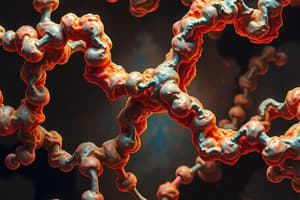Podcast
Questions and Answers
What are enzymes?
What are enzymes?
Biological catalysts that speed up biochemical reactions in living cells.
What is a characteristic of enzymes?
What is a characteristic of enzymes?
- They are only found in animal cells.
- They are consumed in biochemical reactions.
- They speed up reactions without being changed. (correct)
- They can catalyze any type of reaction.
Which of the following is an example of a biochemical pathway?
Which of the following is an example of a biochemical pathway?
- Photosynthesis
- Glycolysis (correct)
- Fermentation
- Cellular respiration
Enzymes are found in both bacterial and animal cells.
Enzymes are found in both bacterial and animal cells.
What is an apoenzyme?
What is an apoenzyme?
A complete active enzyme system containing one or more cofactors is called a ______.
A complete active enzyme system containing one or more cofactors is called a ______.
What are the two distinct types of proteins mentioned?
What are the two distinct types of proteins mentioned?
What is the primary structure of a protein?
What is the primary structure of a protein?
Most enzymes are fibrous proteins.
Most enzymes are fibrous proteins.
What distinguishes globular proteins from fibrous proteins?
What distinguishes globular proteins from fibrous proteins?
What is the molecular weight of proteins expressed in?
What is the molecular weight of proteins expressed in?
Which of these statements correctly describes the role of enzymes in living organisms?
Which of these statements correctly describes the role of enzymes in living organisms?
What elements are typically included in the composition of an enzyme?
What elements are typically included in the composition of an enzyme?
What is the significance of peptide bonds in proteins?
What is the significance of peptide bonds in proteins?
How many common amino acids are generally found in proteins?
How many common amino acids are generally found in proteins?
Which protein structure is characterized by coiling into an alpha helix?
Which protein structure is characterized by coiling into an alpha helix?
What happens to proteins when the need arises for energy or raw materials?
What happens to proteins when the need arises for energy or raw materials?
What role do enzymes play in biochemical reactions?
What role do enzymes play in biochemical reactions?
Which of the following statements accurately describes enzyme specificity?
Which of the following statements accurately describes enzyme specificity?
What is the main distinction between an apoenzyme and a cofactor?
What is the main distinction between an apoenzyme and a cofactor?
Which of the following reactions illustrates the function of enzymes in metabolic processes?
Which of the following reactions illustrates the function of enzymes in metabolic processes?
What is a holoenzyme?
What is a holoenzyme?
How do enzymes affect the activation energy of biochemical reactions?
How do enzymes affect the activation energy of biochemical reactions?
Which of the following is NOT a function of enzymes?
Which of the following is NOT a function of enzymes?
In what type of environments do enzymes typically operate optimally?
In what type of environments do enzymes typically operate optimally?
What distinguishes oligomeric enzymes from monomeric enzymes?
What distinguishes oligomeric enzymes from monomeric enzymes?
Which statement is true regarding metal ions in enzymes?
Which statement is true regarding metal ions in enzymes?
What is a characteristic feature of carboxypeptidase A?
What is a characteristic feature of carboxypeptidase A?
How does feedback inhibition regulate the activity of oligomeric enzymes?
How does feedback inhibition regulate the activity of oligomeric enzymes?
What type of enzyme is classified as a dimeric enzyme?
What type of enzyme is classified as a dimeric enzyme?
What is the molecular weight threshold for oligomeric enzymes?
What is the molecular weight threshold for oligomeric enzymes?
Which of the following enzymes is commonly known to be oligomeric?
Which of the following enzymes is commonly known to be oligomeric?
What are protomers in the context of oligomeric enzymes?
What are protomers in the context of oligomeric enzymes?
What is the significance of quaternary structures in biomolecules?
What is the significance of quaternary structures in biomolecules?
What type of enzymes consist of a single polypeptide chain?
What type of enzymes consist of a single polypeptide chain?
Why are proteolytic enzymes produced in an inactive form?
Why are proteolytic enzymes produced in an inactive form?
Which of the following describes a characteristic of quaternary structures in biological systems?
Which of the following describes a characteristic of quaternary structures in biological systems?
What happens to a monomer when it assembles into a quaternary structure?
What happens to a monomer when it assembles into a quaternary structure?
What is the approximate molecular weight range for monomeric enzymes?
What is the approximate molecular weight range for monomeric enzymes?
What process does chymotrypsinogen undergo to become active?
What process does chymotrypsinogen undergo to become active?
How do hydrophobic sections of monomers behave in the presence of water?
How do hydrophobic sections of monomers behave in the presence of water?
What best describes the active site of an enzyme?
What best describes the active site of an enzyme?
How many amino acid residues typically comprise the catalytic groups of an enzyme's active site?
How many amino acid residues typically comprise the catalytic groups of an enzyme's active site?
Which of the following forces is primarily involved in substrate binding at the active site of an enzyme?
Which of the following forces is primarily involved in substrate binding at the active site of an enzyme?
What role does the tertiary structure of an enzyme play in its active site?
What role does the tertiary structure of an enzyme play in its active site?
What is the typical strength range of the free energy of interaction between an enzyme and its substrate?
What is the typical strength range of the free energy of interaction between an enzyme and its substrate?
In the context of enzymes, what is a catalytic site?
In the context of enzymes, what is a catalytic site?
Where do the residues that constitute the active site typically occur in an enzyme?
Where do the residues that constitute the active site typically occur in an enzyme?
What typically allows for the specificity of an enzyme towards its substrate?
What typically allows for the specificity of an enzyme towards its substrate?
Flashcards are hidden until you start studying
Study Notes
Enzymes Overview
- Enzymes are primarily proteins that act as biological catalysts, accelerating biochemical reactions in living cells without changing themselves.
- They increase reaction rates by a factor of 10^2 to 10^8.
- Enzymes are involved in numerous metabolic processes, such as glycolysis, where glucose transforms into pyruvate.
- Enzymes are essential for reading genetic information from DNA and synthesizing non-protein cell components.
- Roughly 2,000 enzymes exist in bacterial cells (e.g., Escherichia coli) and about 10,000 in eukaryotic animal cells.
- Enzymes have diverse applications in healthcare, food production, and various industries due to their specificity.
Structure of Enzymes
- Enzymes are constituted either solely of proteins or in conjunction with non-protein molecules or metal ions.
- The protein component is termed apoenzyme, and the non-protein part is a cofactor, which can be inorganic (metal ion) or organic (coenzyme).
- A complete and active enzyme system is referred to as a holoenzyme, derived from the combination of an apoenzyme and its cofactor.
Protein Structure and Function
- Most enzymes are proteins, necessitating an understanding of protein structure for enzyme comprehension.
- Proteins are large macromolecules with molecular weights exceeding several thousand Daltons, constituting more than half the dry weight of cells.
- Two main protein types exist:
- Fibrous Proteins: Insoluble in water; provide structural support (e.g., α-keratin in hair, collagen in skin).
- Globular Proteins: Generally soluble and compact, playing functional roles (most enzymes fall into this category).
- Each protein has a specific function tied to its structure and shape, differentiating them from polysaccharides and lipids which primarily serve energy storage.
- Proteins can be degraded for energy or building materials as needed.
Protein Structure Levels
- Primary Structure: Sequential arrangement of amino acids connected by peptide bonds, including disulfide bonds.
- Secondary Structure: Polypeptides can form structures like α-helices, contributing to overall protein functionality.
Enzymes Overview
- Enzymes are primarily proteins that act as biological catalysts, accelerating biochemical reactions in living cells.
- They significantly increase reaction rates, often by 10^2 to 10^8 times.
- Enzymes are crucial for metabolic processes, such as glycolysis, which converts glucose to pyruvate.
- Over 2000 enzymes can be found in bacteria, while eukaryotic animal cells contain around 10,000 different enzymes.
- Enzymes are utilized in various applications, including hospital diagnostics, food manufacturing, and meat tenderization.
Enzyme Structure
- Enzymes are categorized as either proteins alone or as proteins combined with cofactors (organic or inorganic).
- The protein portion is called an apoenzyme, while the complete enzyme structure with cofactors is termed a holoenzyme.
- Simple enzymes consist solely of proteins, while conjugated enzymes require additional molecules for activity.
Protein Structure
- Proteins are macromolecules with molecular weights typically over several thousand Daltons, constituting over 50% of cellular dry weight.
- Types include fibrous proteins (e.g., keratin, collagen) and globular proteins, the latter being more prevalent among enzymes.
- Proteins serve specific functions based on their structure but can also provide energy or raw materials when necessary.
Levels of Protein Structure
- Primary structure involves the sequence of amino acids linked by peptide bonds.
- Secondary structures include formations like α-helices and β-sheets arising from hydrogen bonding.
- Tertiary structure represents the 3D folding of a single polypeptide, affecting functionality.
- Quaternary structure involves multiple polypeptide chains (subunits) and can form complex functional assemblies.
Types of Enzymes
- Monomeric enzymes consist of a single polypeptide chain, found predominantly in hydrolytic reactions (e.g., trypsin, chymotrypsin).
- Oligomeric enzymes contain two or more polypeptide chains (subunits), can be dimers or tetramers, and generally possess a higher molecular weight than monomeric enzymes.
- Oligomeric enzymes often demonstrate cooperative properties, which are absent in isolated units, and are regulated by feedback inhibition.
Cofactors
- Cofactors are necessary small molecules or ions that assist enzyme function.
- Metal ions play crucial roles, leading to classifications such as metalloenzymes (tightly bound metal) and metal-activated enzymes (looser binding).
Active Site Features
- The active site is the enzyme region that binds substrates and contains catalytic amino acids, typically around 12.
- Enzymes are large compared to substrates; only a small portion is directly involved in catalysis.
- Active sites form intricate 3D pockets designed for substrate interaction.
- Weak interactions (e.g., electrostatic, hydrogen bonds) facilitate substrate binding within the active site, compared to the strength of covalent bonds.
Sites Within Enzymes
- Two key functional sites in enzymes are identified:
- Catalytic site: Involved in the catalytic process.
- Regulatory site: Modulates enzyme activity and interaction (not detailed in the text provided).
Studying That Suits You
Use AI to generate personalized quizzes and flashcards to suit your learning preferences.




